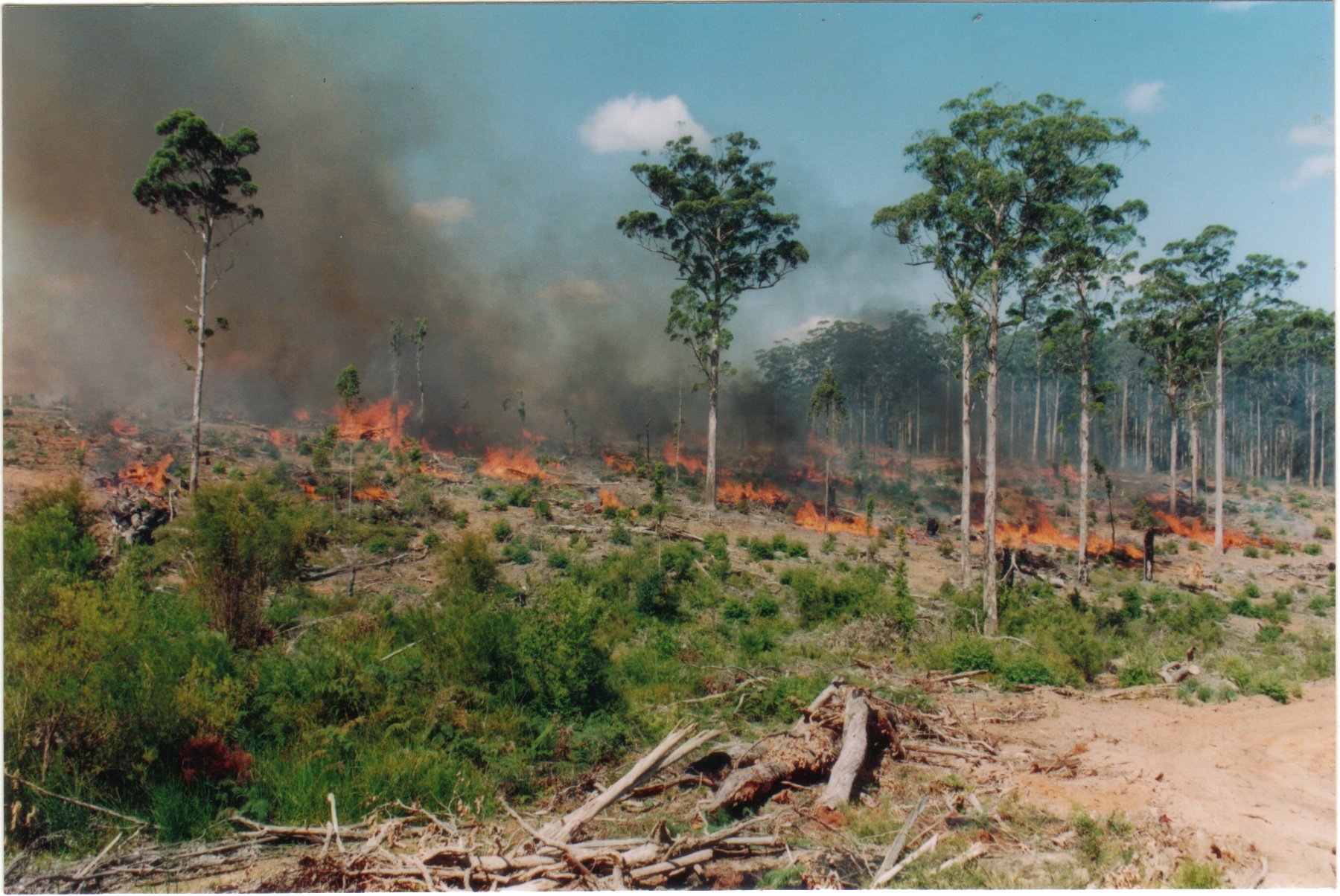Here we are considering planned burns undertaken under mild weather conditions to achieve a reduction in fuel loads. They are variously referred to as fuel reduction burns (FRB), prescribed burns or controlled burns.
It is important to understand that when an area has had its understorey fuel reduced by a low intensity burn, it does not become a firebreak, in the sense that it will stop a running fire, unless the burn has been moderately intense, as is often the case with an autumn season burn. The crucial change, with respect to fire management, is that when the fuel is do reduced, fire behaviour is less intense and it is possible to attack a fire front under even quite severe weather conditions. For example, in jarrah forest fuels, once the litter has accumulated beyond about five years, frontal attack will fail, but can succeed when the litter is less than five years old.
Except for a special type of burn, one required to be intense to create ashbeds for karri regeneration, burns are not intended to remove all litter and understorey vegetation. The usual objective, in a burn intended to reduce forest fuel, is to have the burn extend over only about 70% of the land area.
A karri regeneration burn. Note the seed trees left to shed seed after the burn.
This means that the more moist sites within the burn envelope will not burn, and these are usually the more important sites for native fauna refuge and feeding. There will be additional unburnt patches scattered through the burn area, and these will serve as centres for recolonisation by insects and small fauna, in the constant ebb and flow of organisms that characterizes natural ecosystems.
Furthermore, in a high proportion of spring burns, the fire does not remove the lowest litter layer, that which is already partly decomposed. Fire intensity, although low, varies considerably throughout a burn, due to variations in fuel loading, and this provides a diversity of impacts on vegetation that promotes biological diversity.
A low intensity burn in jarrah forest.
For example, patches of land that did not ignite in one burn, may well ignite in the next burn, 5 years or so later, and because they carry twice the fuel load, will burn at higher intensity, adding to the diversity of fire impacts in the burn. To maintain fuel loads at a level that will prevent the development of high intensity wildfires, it is necessary to repeat the burns at intervals that depends on the forest type and rainfall zone. In the northern jarrah forest, for example, a burn cycle of five years will prevent the development of a crown fire. On the eastern edge of the jarrah forest the burn interval is more like seven years. In the karri and mixed karri-marri forest the burn interval is longer, some 8-10 years, depending on the situation.
Some parts of the forest are withheld from burning for considerably longer periods, mainly after a stand has been regenerated and the regrowth has to be protected from fire for 10-20 years.
The season of burning has a significant impact on fire intensity. Most prescribed burns take place in the spring period, from September to November (December in the south), because that is the time of year when the fuel drying rate, a critical factor in burn planning, is most regular, and weather conditions are most favourable.
Autumn burns generally have higher fire intensity and it is more difficult to restrict the fire to the planned 70% areal coverage. Scorch height is always greater in autumn burns. The weather in autumn is more unpredictable. Early rains that produce good conditions for fuel reduction burning may be followed by dangerous fire weather when a burn may escape and cause severe damage. Conversely, in some years, no autumn burning is possible as the rains start and continue in such as way as to prevent the necessary litter drying process.
The planning process has, for many years, attempted to program burns on a particular area so that two or three spring burns are followed by an autumn burn, as a precautionary measure to avoid any unforeseen adverse biological impacts. However, this is not always possible. These days, it may take up to three years to complete all the processes involved in planning a burn. The list of instructions used by the former DEC for planning a burn ran to over 70 pages. It was extremely complex and comprehensive, covering such areas as:
A technical burn description.
Background information on the particular area.
Checklists for the day of the burn, action plan and maps.
Procedure for post-burn assessment.
Lists of notifications to be sent in advance of the burn.
Post burn evaluation and report.
Every burn prescription must be checked and signed off by nine separate officers responsible for different aspects of management. A public consultation plan is required for each burn where potential issues are addressed. The burn prescription itself specifies the precise fuel moisture and weather conditions, the maximum permissible scorch height, rate of spread and wind direction.
Other preparatory work includes flora and fauna surveys, dieback disease survey and provision for protection of any research plots, recreational or tourist sites, and especially fragile areas.

